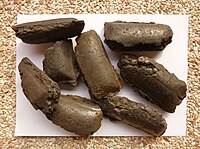
Photo from wikipedia
The reduction gas used in the gas-based direct reduction iron-making process contains CH4 in different concentrations, which has an important effect on the gas and heat needed for the reduction… Click to show full abstract
The reduction gas used in the gas-based direct reduction iron-making process contains CH4 in different concentrations, which has an important effect on the gas and heat needed for the reduction of iron oxide. To investigate the influence of CH4 on gas utilization rate and heat needed at 900 °C, the initial conditions are set as H2% + CO% = 90, CH4% + N2% = 10, gas pressure 1–9 atm, and 0.5 mol Fe2O3, and the equilibrium state composition is calculated using the minimum free energy method. The utilization rate of total gas can be improved, and gas demand can be decreased by increasing CH4 concentration or H2 concentration or reducing gas pressure. For the production of per ton of Fe from 25 °C to 900 °C, 6.08–7.29 m3 of reduction gas, and 7.338–8.952 MJ of gas sensible heat can be saved by increasing 1 m3 CH4, while 10.959–11.189 MJ of reaction heat is increased. Compared with 3390.828–3865.760 MJ of the total heat of per ton of Fe for the reduction by H2 + CO, 2.174–3.703 MJ of total heat is increased by increasing 1 m3 CH4, and the increase ratio is 0.065–0.096%. This study is helpful to improve the gas efficiency and lower the pursuit of higher concentration of H2 + CO in reduction gas.
Journal Title: Energies
Year Published: 2020
Link to full text (if available)
Share on Social Media: Sign Up to like & get
recommendations!